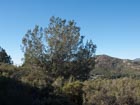
Mature tree in habitat at Guatay [C.J. Earle, 2012.12.19].
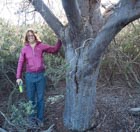
Mature tree in habitat, largest we found at Guatay, showing typical bark and growth habit [C.J. Earle, 2012.12.19].

Foliage, mature seed cones, and pollen cones on a tree at Guatay [C.J. Earle, 2012.12.19].
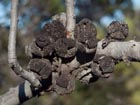
Old cones that have opened and shed their seed, without a fire, at Guatay [C.J. Earle, 2012.12.19].
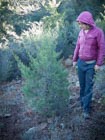
A healthy sapling at Guatay [C.J. Earle, 2012.12.19].

Seedling at Guatay about 8 cm tall [C.J. Earle, 2004.04.07].
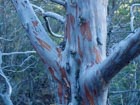
Bark on a tree at Guatay. The variegated pattern is common [C.J. Earle, 2012.12.19].
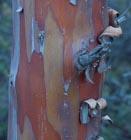
Another view of the distinctive bark [C.J. Earle, 2012.12.19].
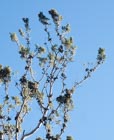
Crown detail showing foliar units and the abundant closed serotinous cones [C.J. Earle, 2012.12.19].
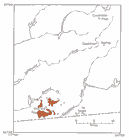
Distribution of Hesperocyparis forbesii (Griffin and Critchfield 1972).

Hesperocyparis forbesii
(Jeps.) Bartel 2009
Common names
Tecate or Forbes cypress (Peattie 1950).
Taxonomic notes
Synonymy: see POWO (accessed 2023.12.16). Type specimen collected 1907.12.30 by Charles N. Forbes in Cedar Cañon between El Nido and Dulzura, on the N side of Otay Mt., in San Diego County, California (Jepson 1922). It was previously (1894.07.05) collected at the same locality by Edgar A. Mearns (Little 1970).
Many recent authors have treated this taxon as a variety of H. guadalupensis, but a molecular analysis by Little (2006) found that H. guadalupensis is slightly more closely related to H. stephensonii (often treated as a variety of H. arizonica). Past authors (Wolf 1948, Little 2006) have found consistent morphological, chemical, phenological, and molecular genetic differences between H. forbesii and H. guadalupensis, and they are here treated as separate species although they are difficult to distinguish using field characters in an artificial setting such as an arboretum. Also see Hesperocyparis for further discussion of the relationship between this and other, closely related Hesperocyparis taxa in northwest Mexico and the adjacent Southwest U.S.
Description
Trees to 10 m tall, often shrubby; crown globose, sparse. Bark of trunks exfoliating, leaving a clear brown or rich cherry-red smooth surface, sometimes only partially peeling away, and persisting as grayish shaggy scales with curling edges. Branchlets decussate, mostly 1-1.5 mm diam. Leaves about 1.2 mm long, acute but rather blunt-tipped, rounded or ridged on the back, light rich (never glaucous) green, often with slightly darkened, inconspicuous, embedded, abaxial gland that does not produce drop of resin except on the larger leaves of vigorous young shoots. Pollen cones abundant, 3-4 × 2 mm; pollen sacs 3-5, slightly 4-sided, of 8 to 14 scales. Seed cones globose, mostly (2)2.5-3.5 cm, brown, not glaucous; scales mostly 4 - 5 pairs, smooth, umbos flat or to 5 mm, dull gray to brown. Seeds mostly 5-6 mm, plump, rich dark brown, not glaucous (Peattie 1950, Eckenwalder 1993).
Farjon (2005) notes that the pollen cones of Hesperocyparis guadalupensis are larger (4-7 mm, vs. no more than 5 mm for H. forbesii) and have a few more microsporophylls. Wolf (1948) finds that on H. forbesii the foliage is bright green and mature trees are not over 10 m tall, while on H. guadalupensis, foliage is more glaucous and mature trees are more than 10 m tall. Farjon (2005) dismisses these differences as "inconsistent."
Distribution and Ecology
USA: California; Mexico: Baja California Norte. In California, occurs in the Santa Ana Mountains (Orange and Riverside counties); also on Guatay Mountain and Otay Mountain (San Diego County) (Barbour 2007, CalFlora 2011). In Baja California Norte, it is found in the Cero Bolo range, in coast ranges north and east of Ensenada, and in interior outliers at Cerro Grande and 10 km S of Tecate (Barbour 2007, Minnich 1987). Habitat chaparral, at 250-1500 m; soils alkaline clay, silicics, and ultramafics (Eckenwalder 1993, Barbour 2007, CalFlora 2011).
Data from CalFlora (2011).
Like many other cypresses, this species is serotinous, the cones opening and shedding seed only after a fire or, occasionally, on extremely hot days. The Tecate cypress is unusual in that many of the cones are borne directly on the trunk or major branchlets. These cones are retained and are sometimes engulfed by stem growth. This situation seems to be directly analogous to the of the closed-cone pines of California, all of which are predominantly serotinous and thus highly fire-dependent. The serotinous pines may open some cones on exceptionally hot days and perhaps that is the case in this species as well, which would explain how it can sustain regeneration despite an ongoing regime of fire suppression. The trees I saw on Guatay Mountain had a mixture of opened and closed cones.
Remarkable Specimens
An ornamental in Fresno, California was 255 cm DBH and 21.34 m tall when measured in 1997 (California Registry of Big Trees 201).
I have not found published age data, but one of the largest trees I have seen had recently lost one of its two major stems in a severe winter storm. The exposed break revealed about 100 growth rings, indicating that this tree, among the largest in the stand, was not more than 120 years old. Since the species is fire-dependent and occurs in chaparral, older individuals are not likely to be found unless a tree by chance establishes on a fireproof site, e.g. on a cliff or rocky barren.
Ethnobotany
No data as of 2023.12.16.
Observations
Little (1970) says that "Perhaps the most accessible grove of Tecate cypress is ... on the Cleveland National Forest, Sec. 21, T. 15 S., R. 4 E., altitude about 4,000 feet [1220 m].". To reach the site, follow Interstate 8 about 40 miles [64 km] E from San Diego and take the CA 79 exit N (towards Cuyamaca Rancho State Park, home of H. stephensonii) for about 4 km. Here, turn E onto Old Highway 80 and go about 3 km to reach the hamlet of Guatay, where a cafe and trailer park can be found. The stand is visible from here on the mountainside to the SW. It is most easily reached by returning down the highway about 500 m, crossing the creek in the valley bottom (forested with large oaks and Coulter pines, Pinus coulteri), and walking W along an old roadbed for not more than 5 minutes until the trees are visible directly uphill. Here a trail can be found winding up through chaparral and into the stand, which is patchy and extends nearly to the mountaintop. When I visited the site, in March 1998, I found trees up to 10 m tall and 85 cm diameter.
Remarks
Jepson (1922) named the species in memory of "my former student, Mr. C. N. Forbes, later Assistant in Botany, Bishop Museum, Honolulu."
Citations
Barbour, M. G. 2007. Closed-cone pine and cypress forests. Pp. 296-312 in Barbour, M.G., T. Keeler-Wolf, and A.A. Schoenherr (eds.), Terrestrial Vegetation of California. University of California Press.
Bartel 2009: described in Adams, R. P., J. A. Bartel and R. A. Price. 2009. A new genus, Hesperocyparis, for the cypresses of the western hemisphere. Phytologia 91(1):160-185.
CalFlora. 2011. Database records from herbaria for locations in Orange, Riverside, and San Diego counties representing Cupressus forbesii, Callitropsis forbesii, Hesperocyparis forbesii, or Cupressus guadalupensis var. forbesii. http://www.calflora.org. Accessed 2011.12.17.
California Registry of Big Trees. 2018. https://californiabigtrees.calpoly.edu/tree-detail/hesperocyparis-forbesii/37, accessed 2018.11.28, now defunct.
Jepson, W. L. 1922. A new species of cypress. Madroño 1:75. Available: Biodiversity Heritage Library, accessed 2021.12.19.
See also
The species account at Threatened Conifers of the World.
Bisbee, Jeff. 2006. Photos at the Cupressus Conservation Project website.
Farjon (2005).
Zedler, Paul H. 1977. Life history attributes of plants and the fire cycle: a case study in chaparral dominated by Cupressus forbesii. P. 451-458 in H.A. Mooney and C.E. Conrad (technical coordinators), Symposium on the environmental consequences of fire and fuel management on Mediterranean ecosystems: Proceedings; 1977 August 1-5; Palo Alto, CA. Gen. Tech. Rep. WO-3. Washington, DC: USDA Forest Service.










